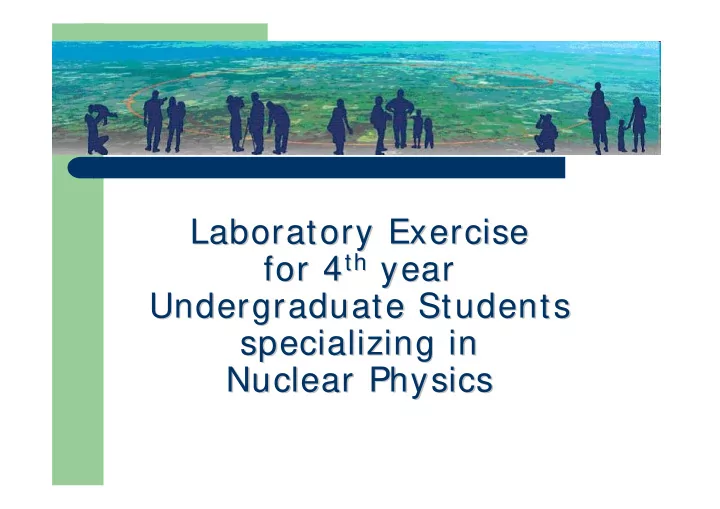

Laboratory Exercise Laboratory Exercise th year for 4 th year for 4 Undergraduate Students Undergraduate Students specializing in specializing in Nuclear Physics Nuclear Physics
Overview � Real LHC events � Each week 2 teams (3 students each) � 30 students total � 1,5 hour introduction � 3 hour exercise � Report and questionnaire
Exercise Goals Exercise Goals � Familiarize students with the LHC and the Familiarize students with the LHC and the � ATLAS experiment ATLAS experiment � Explain how particle detectors work Explain how particle detectors work � � Emphasize the different signatures of Emphasize the different signatures of � particles particles � Demonstrate how a physicist analyses a real Demonstrate how a physicist analyses a real � event event
HYPATIA v.6 – – Physics lab Physics lab HYPATIA v.6 � Special version for this exercise Special version for this exercise � � Only reconstructed inner detector tracks are Only reconstructed inner detector tracks are � shown in the tables shown in the tables � Muon tracks are shown in the canvas Muon tracks are shown in the canvas � �� muon inner �� � Corresponding Corresponding inner muon tracks are tracks are � automatically selected automatically selected � Only inner detector tracks are used for invariant Only inner detector tracks are used for invariant � mass calculations mass calculations
Lab Notes � 22-page instructions booklet (Greek or English) � Introduction to the Standard Model � Detailed description of the ATLAS experiment � Exercise Description � HYPATIA instructions
Exercise 1 Exercise 1 Recognize electrons and muons Recognize electrons and muons � See how different particles show up on the detectors See how different particles show up on the detectors � � Demonstrate the importance of different canvas Demonstrate the importance of different canvas � views views � Explain differences between electrons and muons Explain differences between electrons and muons � � Familiarize students with HYPATIA Familiarize students with HYPATIA � � Uses Uses simulated simulated events events �
Exercise 2 Exercise 2 Recognize Z particle decays Recognize Z particle decays � Learn to separate Z decays form background Learn to separate Z decays form background � dijets � � muons) events (cosmics cosmics and and dijets muons) events ( � µ Z � + µ - � More complex recognition procedure ( More complex recognition procedure (Z µ + µ - � isolated/non- -isolated isolated) ) isolated/non � Uses Uses real real LHC LHC events (5 groups, 30 events events (5 groups, 30 events � each, 14 Z, 16 background) each, 14 Z, 16 background)
Exercise 2 Exercise 2 Recognize Z particle decays Recognize Z particle decays � Explain Explain ETmiss ETmiss � � Introduce the concept of Invariant Mass Introduce the concept of Invariant Mass � and how to calculate it and how to calculate it � Highlight the importance of Histograms Highlight the importance of Histograms � � Calculate Z Calculate Z � mass and width mass and width
Exercise 3 Exercise 3 Find the Higgs Find the Higgs � Discover the Higgs particle hidden among 9 Discover the Higgs particle hidden among 9 � background events background events � Easy exercise Easy exercise � � Gives the sense of discovery Gives the sense of discovery � � Explain the importance of the Higgs Boson Explain the importance of the Higgs Boson � � Uses Uses simulated simulated events events �
Report and Questionnaire � Students need to write a report containing their results � Questions on the results � Explain deviation from theory � Judge their understanding of the exercise � Questionnaire about the quality and impressions from the exercise
Recommend
More recommend